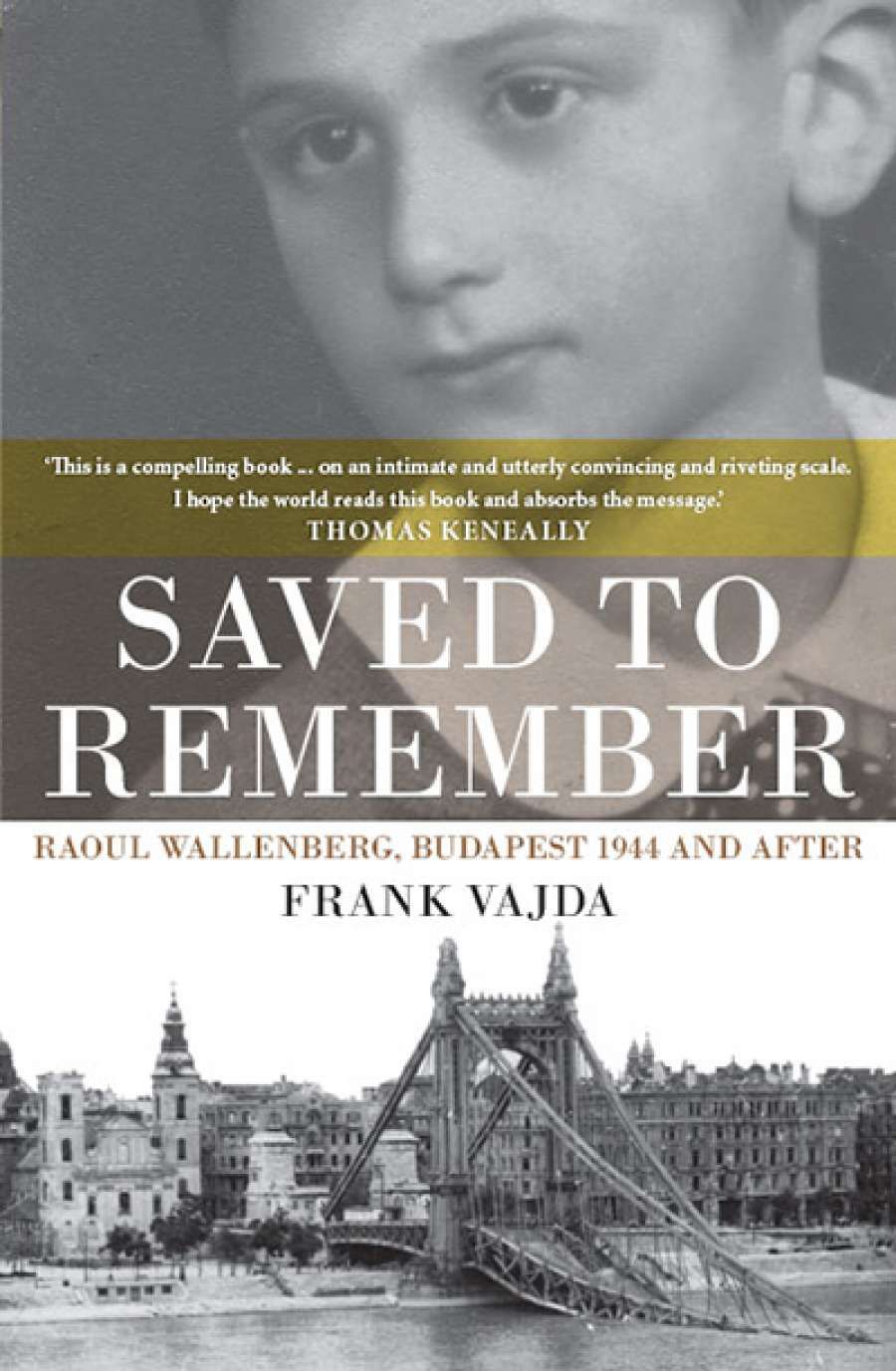
- Free Article: No
- Contents Category: Memoir
- Custom Article Title: Agnes Nieuwenhuizen reviews 'Saved to Remember: Raoul Wallenberg, Budapest 1944 and after' by Frank Vajda
- Custom Highlight Text:
'Is the Mystery of Raoul Wallenberg's Death Finally Solved?' asked a headline in Israel's Haaretz newspaper, on 6 August 2016. The New York Times published a similar story ...
- Book 1 Title: Saved to Remember
- Book 1 Subtitle: Raoul Wallenberg, Budapest 1944 and after
- Book 1 Biblio: Monash University Publishing $34.95 pb, 158 pp, 9781925377088
An only child, Vajda was nine in 1944 and sheltering with his mother in one of Wallenberg's 'safe houses'. He testifies:
Wallenberg removed people from deportation trains, rescued children out of convoys and returned groups of people ... before they could be transferred to Eichmann's hands ... He rushed to execution sites ... saving hundreds of people in the face of the power crazy murderers by using his assumed power, his charisma and bribes to induce the release of 'Swedish protégés'.
Vajda 'survived by a series of near misses and coincidences', of which he details eight. He does not allow himself much emotional expression except when talking about his beloved mother who died in his youth and to whom, in her years of illness, Vajda feels he did not devote enough attention. He writes: 'I seriously contemplated suicide and felt absolutely devastated when the end came.' Not an observant Jew himself, Vajda notes: 'There are many different attitudes among Jews', and he has some sharp words about some of the more hard-line views. He has made a considerable contribution to Jewish life and been widely honoured for this.
Short sections document key personal and public aspects and events: 'Historical Anti-Semitism in Hungary', 'The Horthy Regime 1941–1944', 'My Maternal Keve Family', 'Two Family Houses', 'My Maternal Grandmother', 'The German Takeover', 'The Deportation of Provincial Jews'. Vajda observes: 'The final reprieve for the remains of Hungarian Jewry was not due to any Axis generosity, but to requests and warnings from the Allies, the Pope and the Swedish King.' Vajda was instrumental in having the first ever honorary Australian citizenship bestowed in 2013 on Wallenberg following the United States, Britain, Budapest (though not Hungary), and Israel. He has dedicated a memorial sculpture to Wallenberg near his Melbourne home. He has also worked closely with others, often at high levels, as well as with Swedish connections, particularly Wallenberg's sister, to establish what befell this exceptional man. For this work, Vajda was awarded the Swedish Royal Order of the Polar Star.
Vajda's secondary education at his cherished Melbourne High School, his training as a doctor, his later specialisations and many achievements and accolades are summarised. There is little about family or an interior or social life. 'My wife Michelle has given unstinting support in these endeavours and my son has brought unparalleled joy to my life.' His son was named after Vajda's three heroes; Simon (Wiesenthal), Raoul, and Leslie (Laszlo) – 'my martyred father'.
 A postage stamp in Hungary dedicated to Raoul Wallenberg (Hungarian Post Office, Wikimedia Commons)
A postage stamp in Hungary dedicated to Raoul Wallenberg (Hungarian Post Office, Wikimedia Commons)
In his introduction Vajda writes: 'This story is not about the Holocaust in its entirety, but rather about responses to events that happened to me.' He presents his early life in compressed detail including contact with various relatives, his schooling or lack thereof; his escape with his mother to Austria by paying a people smuggler; their wait in difficult circumstances before being accepted as immigrants by Australia.
Frank Vajda became a distinguished neurologist, specialising in drugs for pregnant women suffering from epilepsy. He founded the Raoul Wallenberg Centre of Clinical Neuro-pharmacology at St Vincent's Hospital in Melbourne, thus bringing together his two consuming endeavours. Saved to Remember is a timely and significant work. It could garner a wider readership with a more arresting cover, better presentation, a less dense typeface, and some judicious pruning in sections on individuals important to Vajda but perhaps not of equal interest to readers. With its four stand-alone chapters on Wallenberg, appendices and testimonials, the book veers between memoir, autobiography, and historical account. The tone is detached except for flashes of anger and sadness at what was perpetrated and lost. Of undeniable power and relevance is this question that still remains to be answered: 'How could the world, and in particular German civilians, claim to have been ignorant of mass murder in Nazi occupied territories, when in July 1944, I, although a child, knew from stories being circulated by word of mouth, about lime pits, gas chambers and showers, into which people were crammed to suffocate them?'


Comments powered by CComment